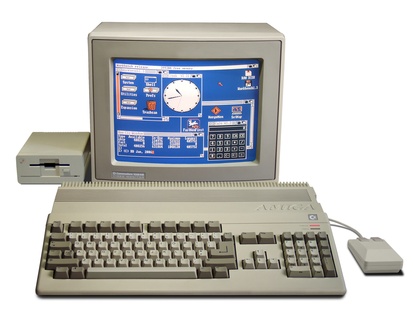Amiga 500
- Company :
- Commodore International
- Price :
- $699
- Year :
- 1987-1992
- Manual :
- Online Manual (Large Download 38 MB)
- Source :
- Donated by Stephen Branagan
The Amiga 500 (A500) was introduced at the World of Commodore Amiga Show (WOCA) in January of 1987. This computer returned Commodore to its roots by selling in the same mass retail outlets that its popular Commodore 64 computers were sold. The original Amiga 500 became Commodore’s best selling computer, especially in European markets, and was a very popular gaming computer due to it advanced graphics and sound at the time.
On the outside, the A500 looked similar to a commodore 128 but had a Motorola 68000 microprocessor running at 7MHz. The CPU was 32-bit internally but used a 16-bit data bus and 24-bit address bus that provided a maximum of 16MB of address space. The earliest A500 models used a similar chipset as the Amiga 1000 with resolutions from 320x200 (up to 32 colors) to 640x200 (up to 16 colors). Two special graphic modes were also available: Extra HalfBrite and Hold And Modify (HAM) which allowed all 4096 colors to be used on the display simultaneously.
A stock A500 computer came with AmigaOS version 1.2 or 1.3 and 512 KB of Chip RAM as well as one built-in double-density floppy disk drive that could ready 880 KB standard Amiga disks and up to 984 KB using custom formatting. The disk drive could also read 720 KB IBM PC disks. A floppy port drive3 allowed daisy-chaining of up to 3 extra floppy disk drives. The computer and keyboard were housed in the same shell similar to the Commodore 64. Besides the capability of connecting the device to a computer monitor, it came with a RF adapter to display video on televisions with a coaxial input. The A500 had a “trapdoor” slot on the bottom that provided for an additional 512 KB of “fast” RAM. One interesting feature for its time was the use of socketed chips which allow for easy replacement of defective chips or upgrade options for newer Motorola microprocessors (68010, 68020, etc).

